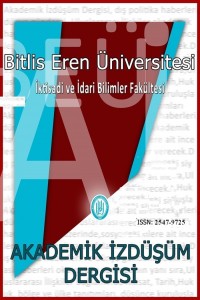Öz
This article concerns the main direction of the
anti-religious campaign of Soviet authorities in Kazakhstan on the example of
Kentau multicultural mono-city. The subject of the study is the policy and
practice of local authorities to fulfill the tasks of the anti-religious
campaign, the response of believers, the forms of their protection and
resistance, the results of the anti-religious campaign in the mono-city. The
article analyzes the religious life of Kentau mono-city, built in the second
half of the 20th century as a "new city", free from the vices of
capitalist society, including religion. When creating new cities, their key
feature and main advantage, according to the ideologists of the Soviet
authorities, was the lack of historical memory, the past in any of its
manifestations, including, in the religious ones. This feature was to
contribute to a more active formation in the mono-city of a new life and a new
type of man - a Soviet man. The author comes to the conclusion that, despite
anti-religious measures on the part of the Soviet authorities and the
declaration of the idea "Kentau is a mono-city without mosques and
churches," the population continued to perform religious activities, and
the spectrum of confessions in the city was wide enough.
Anahtar Kelimeler
Anti-religious campaign Kentau mono-city Communist ideology Everyday life Soviet authorities.
Kaynakça
- Abdikhanov, A Confessions of Southern Kazakhstan at the end of the XIX - 80s of the XX century: historical analysis, Doctoral Thesis. West Kazakhstan University named after Utemisov, Uralsk, 2010.
- Abdrakhmanova, K. The everyday life of the cities of Central Kazakhstan in 1945-1953, Doctoral Thesis, Karaganda State University, Karaganda, 2009.
- Atabekova, R. Kentau: alpys zhyl-alpys beles, Oner, Almaty, 2015.
- Archive of the President of the Republic of Kazakhstan, F.708, Op.31, D.169.
- Archive of the President of the Republic of Kazakhstan, F.708, Op.33, D.1508.
- Archive of the President of the Republic of Kazakhstan, F.708, Op.57, D.1421.
- Archive of the President of the Republic of Kazakhstan, F.708, Op.65, D.1293.
- Auanasova, B. History of the evolution of religious relations in Kazakhstan in 1917-1991. Doctoral Thesis. West Kazakhstan University named after Utemisov, Uralsk, 2007.
- Brodel, F The structures of everyday life: the possible and the impossible, L. Kubel (ed.). Progress, Moscow, 1986.Kentau regional state archive, F.57, Op1, D.489.
- Koigeldiev, M. The phenomenon of labor in the Soviet society, Karatau, Almaty, 2016.
- Maulenkulov, S. Working prowess of Achisay, Erkin and K-XXI, Kentau, 2010.
- Mukhtarova, G. Islam in Soviet Kazakhstan in 1917-1991, Doctoral Thesis, West Kazakhstan University named after Utemisov, Uralsk, 2007.
- Nurlanova, N. The main problems of socio-economic development of mono-cities in Kazakhstan, Scientific Heritage, Almaty, 2012.
- Sadykovа, A. The policy of the Soviet authorities in the sphere of religion (1918-1953), Doctoral Thesis, Kazakh National University named after Al-Farabi, Almaty, 2015.
Ayrıntılar
| Birincil Dil | İngilizce |
|---|---|
| Bölüm | Makaleler |
| Yazarlar | |
| Yayımlanma Tarihi | 30 Aralık 2018 |
| Yayımlandığı Sayı | Yıl 2018 Cilt: 3 Sayı: 4 |
Yayın için kabul edilen yazıların yayın hakkı ve yayınlanan yazılarında her türlü telif hakları dergiye aittir. Yazara herhangi bir telif hakkı ödenmez.

